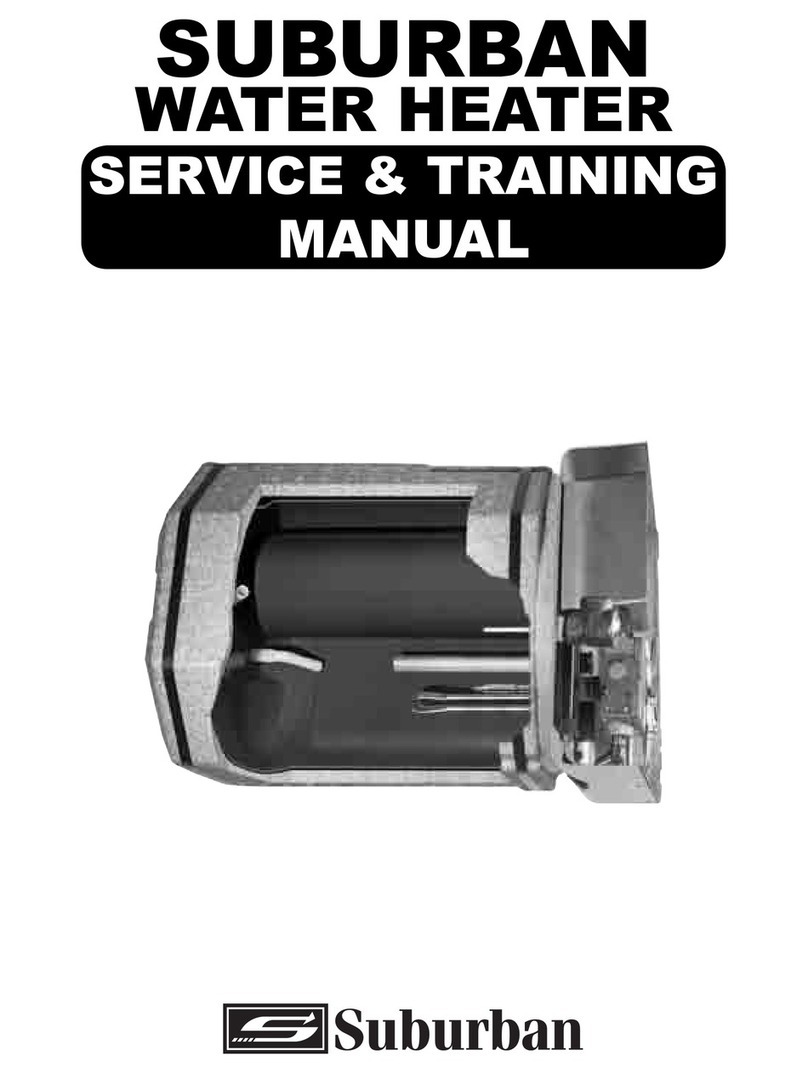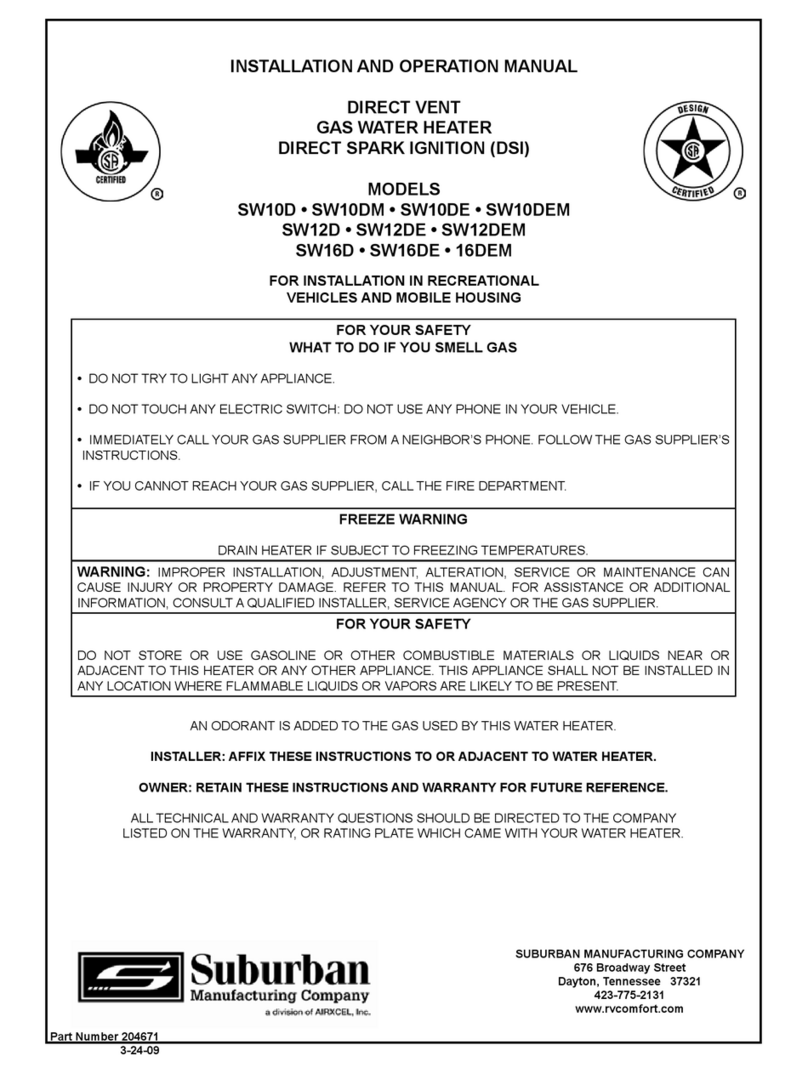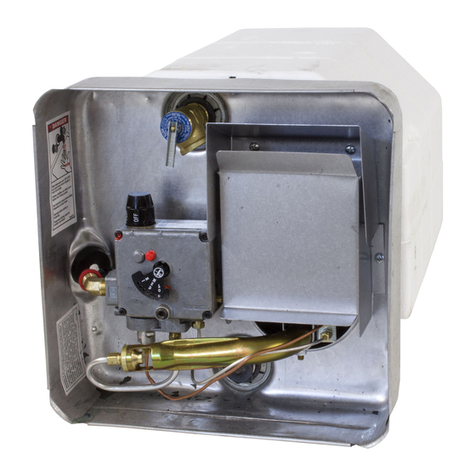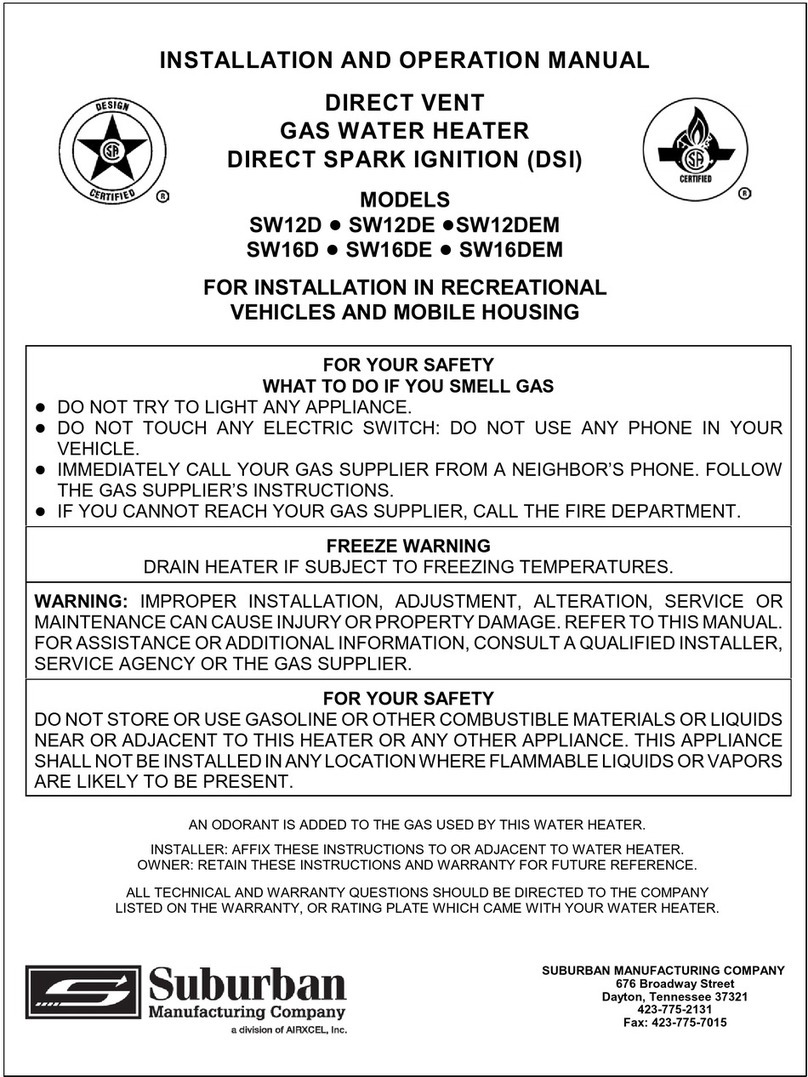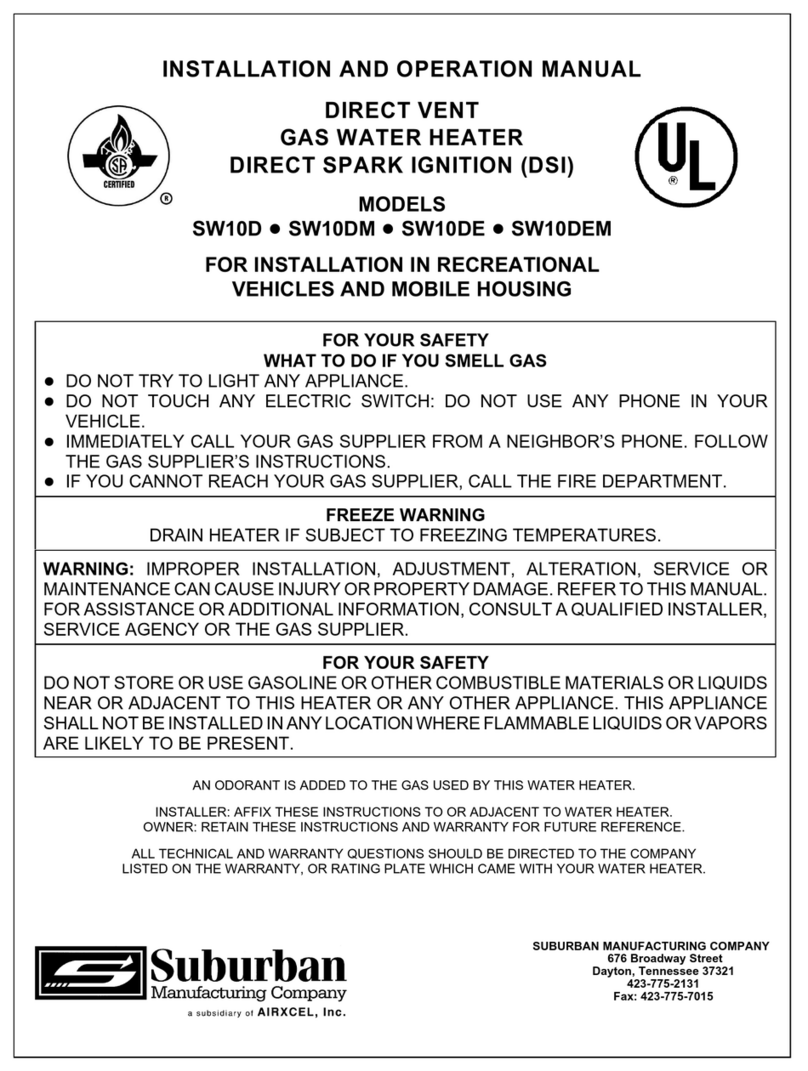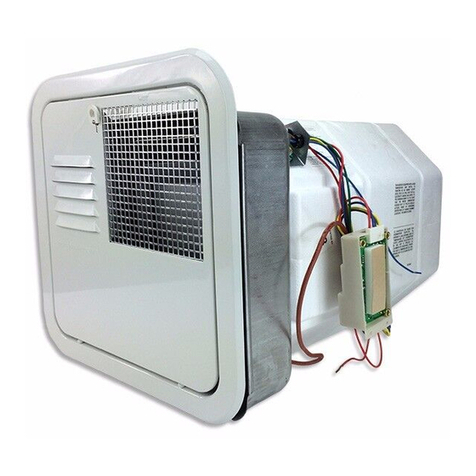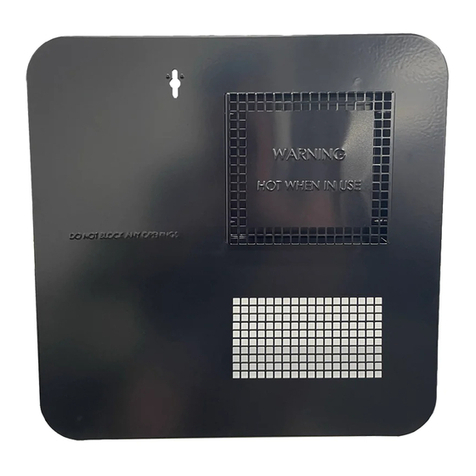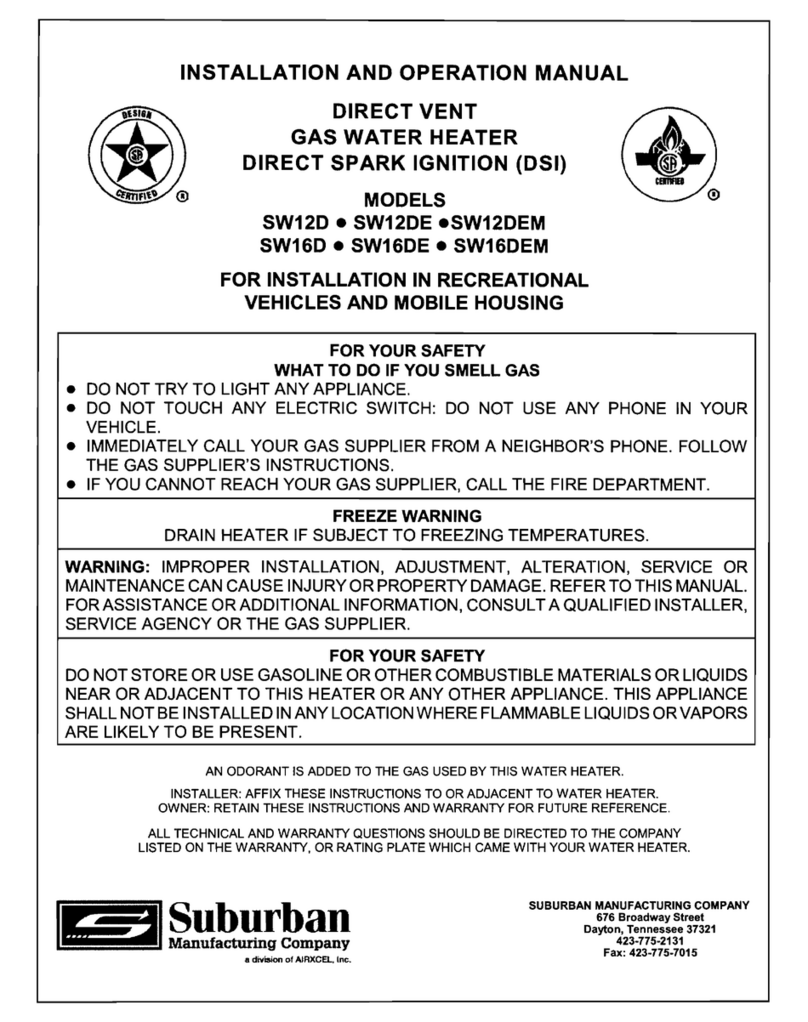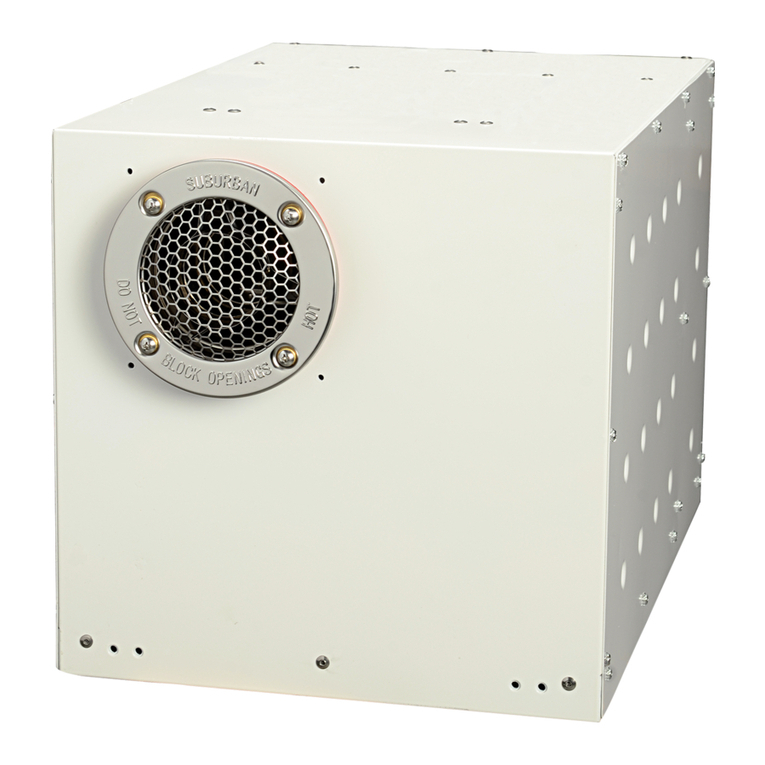
5
Figure 11
Figure 10
B. Periodically inspect unit for soot. If soot is present anywhere on water heater,
immediately shut unit down and contact your dealer or a qualified service person.
Soot is a sign of incomplete combustion and must be corrected before operating
water heater. Areas to check would include:
1. Check for an obstruction in burner or the flue box.
2. Check the screen in the door to see that no foreign material has accumulated
to prevent flow of combustion and ventilating air.
3. Check to be sure there is no flame present at burner orifice or burner whenever
main gas valve is closed. This can be checked by turning the OFF\ON switch to
the “OFF” position.
C. Frequent checks should be made of the grommet on the gas inlet to assure
tight seal. (See “Making Gas Connections”).
D. Periodically check wiring and wire connection to be sure wiring is not
dam aged/frayed and that all terminals and connections are tight and in
compliance with codes (See “Making Wire Connections”).
SAFETY WARNINGS
WARNING! It is imperative that the water heater tank be filled with water
before operating the water heater. Operation of the water heater without
water in the tank may result in dam age to the tank and/or controls. This
type of damage is not covered by the limited warranty.
WARNING! Hydrogen gas may result if you have not used this heater for
two weeks or more. HYDROGEN GAS IS EXTREMELY FLAMMABLE. To
reduce the risk of injury under these conditions, open the hot water faucet
for several minutes at the kitchen sink before you use any electrical
appliance connected to the hot water system. If hydrogen is present, you
probably will hear an unusual sound such as air escaping through the
pipe as the water begins to flow.
Hydrogen gas may be present even after water has been drained from the
tank. Open faucet at sink and allow system to vent for several minutes (5-
10 m inutes).
Do not smoke or have any open flame near the open faucet. Do not
attempt to light pilot or main burner. On DSI models, be sure the switch
is “OFF”.
Should overheating occur, or the gas supply fail to shut off, shut off the
manual gas valve to the appliance before shutting off the electrical supply.
Do not use this appliance if any part has been submerged under water.
Immediately call a qualified service technician to inspect the appliance
and to replace any part of the control system and any gas control that has
been submerged under water.
Do not alter the operation of your water heater nor change the
design/construction of yourwater heater.Accessories are being marketed
for RV products which we do not recom mend. For your safety,
only factory authorized parts are to be used on your water heater.
Periodically inspect the vent for obstructions or presence of soot. Soot is
formed whenever combustion is incomplete. This is your visual warning
that the water heater is operating in an unsafe manner. If soot is present,
immediately shut the water heater down and contact your dealer or a
qualified service person.
When considering add-on rooms, porch or patio, attention must be given
to the venting of your water heater. For your safety, do not terminate the
vent on your water heater inside add-on room s, screen porch or onto
patios. Doing so w ill result in products of com bustion being vented into
the rooms or occupied areas.
Never operate the heater if you sm ell gas. Do not assum e that the smell
of gas in your RV is norm al. Any time you detect the odor of gas, it is to
be considered life threatening and corrected immediately. Extinguish any
open flames including cigarettes and evacuate all persons from the
vehicle. Shut off gas supply at LP gas bottle. (See Safety notice on front
cover of this manual.)
NOTE: Always open both the cold and hot water faucets when filling
vehicle water tank to allow air pockets to be forced out of the water heater.
When water flows from the heater faucets, close both faucets.
WARNING! Do not store or use combustible materials or liquids near or
adjacent to this heater.The appliance shall not be installed in any location
where flam m able liquids or vapors are likely to be present.
Be sure the power is "OFF" to the water heater ignition system during any
type of refueling and while vehicle is in motion or being towed.
The thermostat on your water heater is not adjustable. It is a temperature
sensing limit designed to m aintain a water tem perature of 130°F (54°C).
Water tem peratures over 125°F (49°C) can cause severe burns instantly
or death from scalds; therefore, be careful when using hot water.
Children, disabled and elderly are at highest risk of being scalded. Always
feel water before bathing or showering.
HIGH ALTITUDE DERATION
Suburban’s water heaters are certified by nationally recognized testing
laboratories for operation without modifications at altitudes up to 4,500 feet.
Operation above this elevation may require derating by 4 percent for every 1,000
feet above sea level. As an example, at 8,000 feet, the water heater should be
derated approximately 32 percent.
If the unit is not properly derated, lack of sufficient oxygen for combustion may
produce improper burner operation. Pilot outage caused by burner lift-off or
sooting from a yellow burner may occur indicating the possibility of carbon
monoxide. You may also notice a lack of efficiency in heating the water because
of incomplete combustion of the burner at these higher altitudes.
Consult with the local gas company, your dealer, an RV service agency or
Suburban Manufacturing Company for proper derating of the unit. Change-out of
the orifice (derating) should be done by the dealer or a qualified service agency.
NOTE: It is important that once the unit has returned to lower elevation (below
4,500 feet) this high altitude deration and pilot adjustments (if equipped) be
reversed for proper operation of the unit.
ANODE PROTECTION
The tank in this water heater is protected by a magnesium or aluminum anode to
prolong the life of the tank by absorbing the corrosive action of hot water. Under
norm al use, the anode rod will deteriorate and because of this, we recom mend it
be replaced yearly. NOTE: W ater with high levels of iron and/or sulfate will
increase the rate of deterioration; therefore, more frequent replacement may be
required. If anode rod is mostly eaten away, replace it with a new one. (See
Figure 11)
Operating the water heater without proper anode protection will decrease tank life
and will void your warranty on the tank. NOTE: Tank is drained by removing
anode rod (See “Drain and Storage” instructions).
To extend anode life, drain water from tank whenever RV is not being used. Avoid
any extended time of non use with water in tank.
Also, refer to section on winterizing.
WARNING! Do not replace the anode rod with any non-Suburban
accessory part, such as an “add-on” electric heating element. Items such
as these are not approved to be installed in Suburban products. They
could create an unsafe condition and will also void all warranties.
6
Figure 12
Figure 13
PRESSURE RELIEF VALVE
The temperature and pressure relief valve is designed to open if the temperature
of the water within the heater reaches 210°F, or if the water pressure in the heater
reaches 150 pounds. Recreational vehicle water systems are closed systems and
during the water heating cycle the pressure build-up in the water system will reach
150 pounds. When this pressure is reached, the pressure relief valve will open
and water w ill drip from the valve. This dripping w ill continue until the pressure is
reduced to below 150 pounds, and the valve closes. This condition is normal and
does not indicate a defective relief valve.
WARNING! Do not place a valve between the relief valve and the tank. Do
not plug the relief valve under any circumstances.
WATER WEEPING OR DRIPPING FROM PRESSURE
RELIEF VALVE
You may experience water weeping or dripping from your water heater’s Pressure
and Temperature (P & T) Relief Valve when your water heater is operating. Water
weeping or dripping from the P & T Valve does not always mean the P & T Valve
is defective. As water is heated, it expands. The water system in a recreational
vehicle is a closed system and does not allow for the expansion of heated water.
When the pressure of the water system exceeds the relieving point of the P & T
Valve, the valve will relieve the excess pressure.
Suburban recommends that a check valve not be installed directly at the inlet to
the water heater tank. This will increase weeping of the pressure relief valve.
WARNING! Do not remove or plug the relief valve.
One way to reduce the frequency of this occurrence is to maintain an air pocket
at the top of the water heater tank. This air pocket will form in the tank by design.
However, it will be reduced over time by the everyday use of your water heater.
To replenish this air pocket:
1. Turn off water heater.
2. Turn off cold water supply line.
3. Open a faucet in the RV.
4. Pull out on the handle of the Pressure Relief (P & T) Valve and allow water
to flow from the valve until it stops.
5. Release handle on P & T Valve - it should snap closed.
6. Close faucet and turn on cold water supply; as the tank fills, the air pocket
will develop.
Repeat this procedure as often as needed to reduce the frequency of the weeping
of the P & T Valve. If the weeping persists after following this procedure, you may
elect to install an expansion or accumulator tank in the cold water line between the
tank and check valve to relieve the pressure caused by thermal expansion.
Contact your local dealer for assistance.
THERMOSTAT AND MANUAL RESET
MODELS: SW12D, SW12DE, and SW12DEM
The m odel water heaters listed above are equipped with a high tem perature limit
as a cut-off device. Temperature above 180°F will cause manual reset button to
trip shutting down main burner.
To activate burner, the water temperature must be below 110°F, push reset button
to re-activate burner.
THERMOSTAT AND MANUAL RESET
MODELS SW12DE and SW12DEM
The m odel water heaters listed above are equipped with a high temperature limit
as a cut-off device. Temperature above 180°F will cause manual reset button to
trip shutting down the electric element.
To activate element, the water temperature must be below 110°F, push reset
button to re-activate the electric element.
DRAINING AND STORAGE INSTRUCTIONS
If RV is to be stored during winter months, the w ater heater must be drained to
prevent damage from freezing.
1. Turn off electrical power to water heater either at the switch from the electrical
element or a breaker.
2. Shut off gas supply to water heater.
3. Turn off pressure pump on water system.
4. Open both hot and cold water faucets.
5. Remove anode rod from tank.
6. Follow RV manufacturer’s instructions for draining entire water system.
NOTE: Be certain to refill water heater with water and remove all air from tank and
lines before re-lighting or before turning on electrical power.
ODOR FROM HOT WATER SYSTEM
Odor from the hot water system is not a service problem and many water supplies
contain sufficient amounts of sulphur to produce an odor. The odor is similar to
rotten eggs and is often referred to as "sulphur water". It is not harmful - only
unpleasant to smell. Sulphur water can be caused by a chemical action or by
bacteria. The solution to eliminate is chlorination of the water system. Add about
six (6) ounces of chlorinated common household liquid bleach to each 10 gallons
in the water tank. Then run the chlorinated water throughout the system, opening
each faucet one at a time until you smell the chlorine. Let the RV sit for a few days
and the chlorine should take care of the problem. Then you will need to take care
of the chlorine. Remove the chlorine by flushing the system with fresh water. This
may take several attempts. You may consider adding a filtering system that
removes chlorine and prevents sulphur w ater. If the sulphur or rotten egg smell
continues, flush the system once again as described above and replace anode rod
as necessary.
REMOVING WATER HEATER
1. Shut off gas supply and disconnect gas supply line from water heater.
2. On all Electric Models, disconnect 120 V.A.C. supply at junction box mounted
on heater.
3. On all DSI Models, disconnect 12 V.D.C. power supply at junction box on
heater.
4. On Models SW12D and SW12DE disconnect all wires at module board.
5. Shut off water supply. Drain water from tank following instructions under
“Draining and Storage”.
6. Disconnect hot and cold water lines from water heater.
7. Remove screws or nails securing control housing to framed opening.
8. Slide heater out. To reinstall, follow instructions in manual under “Installation
Instructions”.
WINTERIZING
If your water heater plumbing system is equipped with a bypass kit, use it to close
off the water heater, drain the water heater completely and leave the water heater
closed off (out of the system) in the bypass position particularly if you are
introducing antifreeze into the plumbing system. Antifreeze can be very corrosive
to the anode rod creating premature failure and heavy sediment in the tank. If the
plumbing system is not equipped with a bypass kit, and you intend to winterize by
adding antifreeze to the system, remove the anode rod (storing it for the winter)
and replace it with a 3/4" drain plug.


